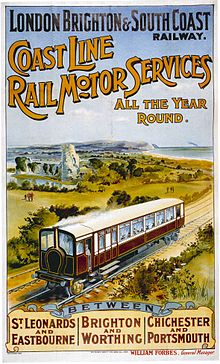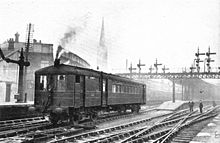Railmotor
A single coach with its own prime mover was a solution adopted in some cases; this may be thought of as the predecessor to the railcar, a term more associated with the use of internal combustion engines.
In many cases the tramways soon adopted electric traction instead, and the attractiveness of the cheap and frequent conveyance abstracted business from the railways in urban areas.
The railways responded by opening new stopping places (to serve more closely the new suburban housing) and sought to reduce their operating cost by reintroducing railmotors, which were cheaper to construct.
The intrinsic compromises in fitting a steam engine inside the limited space available made them mechanically inefficient, and their power was typically insufficient to handle attached vehicles for parcels or additional coaches at times of exceptional demand such as public holidays.
This meant they were unable to cope with greater than expected passenger demands – a classic example being busy market days on an otherwise lightly used rural branch line.
The South Eastern and Chatham Railway built its P Class of small, light tank locomotives specifically to replace railmotors in the 1900s, while the London and South Western Railway introduced its C14 Class which were essentially self-contained railmotor power units that allowed greater flexibility by separating the engine and the carriage sections for working as push-pull trains.
The engine unit, built by Kitson and Company of Leeds, England, consists of a small saturated locomotive-type boiler and a cab fitted on a four-wheel (720 mm diameter) underframe.
Two outside cylinders delivering 8.96 kN (2,015 lbf) of tractive effort drive the rear axle, which is the only one powered; valve gear is Walschaerts.
The coach unit, finished in dark oak-stained and varnished timber, was built by the Metropolitan Amalgamated Railway Carriage and Wagon Company of Birmingham.
Its regular duty was a weekly trip to Hawker, 65 km (40 mi) away, hauling a four-wheel van to carry parcels and mail.
It spent its entire working life operating out of the Quorn locomotive depot until 1932, when it was stored and, later, publicly displayed at Port Augusta and Alice Springs.





